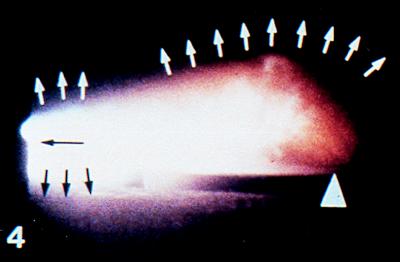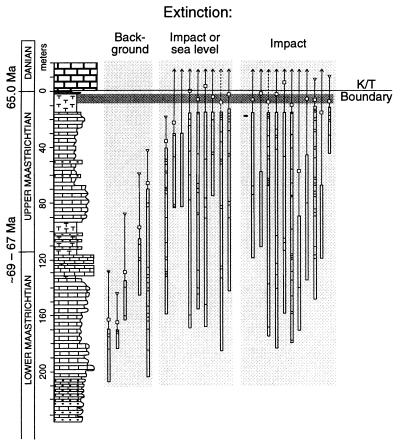Confirmation that a large meteorite impact in Mexico correlates with a mass extinction (about 76% of fossilizable species), including the dinosaurs, is revolutionizing geology. The significance of this 65-million-yr-old event, which marks the boundary between the Cretaceous and Tertiary geological periods (known as the K/T boundary), is best understood when placed in an historical context. Georges Cuvier (1769–1832) first developed the concept of mass extinction based on the recognition of abrupt changes in the fossil record. This concept was radically altered by the publication of Charles Lyell’s Elements of Geology in 1830 and Charles Darwin’s The Origin of Species in 1859. Lyell explained the abrupt disappearance of fossils by gaps in the geological record. Such gaps were critical to Darwin’s theories of natural selection because of the lack of good fossil evidence for transmutation of one species into another. So influential were the works of Lyell and Darwin that in 1886 Angelo Heilprin wrote the following about the abrupt change in fossils across the K/T boundary in his book Geographical and Geological Distribution of Animals:
It is illogical, and directly opposed to the workings of evolutionary force, to conceive of a wide-spread group of animals suddenly appearing and springing into prominence; and no less illogical to conceive of an equally sudden extermination. Hence, where vast differences in the faunas of any two succeeding geological periods present themselves we have reasonable grounds for concluding that a long lapse of time has intervened between the close of one period and the commencement of the [next]… .
This rejection of abrupt mass extinction prevailed until the late 1970s when a team of scientists lead by Luis and Walter Alvarez set out to measure the amount of cosmic dust in the K/T boundary. They hoped to use the dust influx rate to refine the duration of the inferred “gap” in the record. Their results shocked the geological community (1). They found that the boundary sediments contained huge amounts of cosmic debris that could only be explained by the impact on earth of a ≈10 km in diameter meteorite. On the basis of this finding, they hypothesized that the mass extinction at the K/T boundary was caused by the shutdown of photosynthesis by a global cloud of impact debris.
Like all good hypotheses, the Alvarez impact hypothesis generated a tremendous amount of exciting and productive research. In the decade that followed the Alvarez paper, hundreds of studies of K/T boundary deposits documented the global fallout of impact debris. Final confirmation of the impact came in the early 1990s with the discovery that the ≈200 km in diameter Chicxulub crater in the Yucatan Peninsula of Mexico is the site of this catastrophic event (2, 3).
Confirmation of the impact portion of the Alvarez hypothesis marks a turning point in the study of the K/T mass extinction, away from speculations about possible causes, to linking the extinctions to a single catastrophic event. Here lies the frontier, which is in part ideological because many geologists still hold tight to the views of Lyell, but it is also methodological because geological data mostly lack the temporal resolution to deal with abrupt causal events. The challenge at this new frontier is to unravel a sequence of events that includes those which occurred in seconds as the meteorite struck the earth, to those covering millions of years before and after the impact.
Advances in computer modeling of the impact, coupled with the knowledge of the target rocks and their behavior under high-pressure shock, have shed light on what happened the first few seconds after impact (4). A key aspect of the Yucatan site is that the upper 3 km of rock were rich in water, carbonate, and sulfate, which upon impact produced about 200 gigatons each of SO2 and H2O vapor and other gases that greatly altered the properties of the stratosphere. Impact models and experiments, coupled with comparisons of the geometry of Chicxulub with that of other craters, suggest that the impact was oblique from the southeast (5). Such a trajectory would focus the blast of hot gasses on North America (Fig. 1), greatly amplifying the effects of the impact on this continent (5). The fossil record supports this view, especially in floral extinctions, which appear to be most severe in North America and were followed by a dramatic burst of ferns, an early colonizer of bare soil. Further study of this apparent pattern of extinctions is hampered by the paucity of data from the southern hemisphere, where much more work is needed.
Figure 1.
Image of the down-range trajectory of the vapor plume produced by an oblique impact (15° from horizontal) of a 5.2 km/s projectile into powered dolomite (Ca and Mg carbonate similar to the sedimentary rocks at Chicxulub). The point of impact is marked by the triangle at lower right. Frame shown (4) is approximately 100 μs after impact. Illumination is solely from hot, glowing vapors. Note the down-range ballistic component of the hot vapors (black arrows), which for Chicxulub would have focused destruction on North America. Experiment conducted by Peter Schultz with the National Aeronautics and Space Administration Ames Vertical Gun. Photographs courtesy of P. Schultz, frame 4 from figure 4, ref. 5.
Early work predicted that smoke and dust from the impact plunged the earth into a freezing blackout. Recent computer simulations and atmospheric models indicate that within a few weeks to months temperatures and light levels would have begun to rebounded due to the release of heat stored in the oceans and the coagulation and fall of the dust and soot (6). The major effects of the dust and soot would last about 1 yr or less. Nevertheless, the devastation may have just begun because the SO2 and water vapors would remain in the stratosphere, starting a series of chemical reactions that produce sulfuric acid aerosols. Models indicate that a global aerosol cloud would be continuously produced for about 12 yr, blocking out over 50% of the sunlight during the first 10 yr (4). The aerosols would have two main effects: cooling the earth, perhaps to near freezing, and as the aerosols fell, drenching the surface with sulfuric acid rain. Accurate estimates of the cooling are difficult to make and must await better climate models capable of simulating a perturbation of this magnitude. It should be emphasized that the devastation described above is largely theoretical, although there is some independent evidence for global acid rain, fires, and cooling.
Paleontologists have long known that a mass extinction of marine plankton occurred abruptly at the K/T boundary (7). The abruptness of the extinction in larger animals is more controversial because large fossils are more rare, thus the incompleteness of the fossil record makes abrupt changes appear gradual. One of the first rigorous statistical tests of the abrupt extinction in larger animals is of ammonites (extinct relatives of the squid with coiled shells) from France and Spain (8). This study demonstrates that there were, at most, three phases of ammonite extinction (Fig. 2): “background” extinction of 25% of the species extending over some millions of years before the K/T boundary; a possible extinction of up to 35% of species associated with a drop in sea level 10,000–20,000 yr before the impact; and, finally, the extinction of about 40–75% of the species at the K/T boundary. This study provides good evidence for a link between the impact and an abrupt extinction of ammonites.
Figure 2.
Graph of the observed temporal ranges of 28 species of ammonite and the positions of the individual fossils (short horizontal dashes). Observed ranges underestimate true ranges due to the incompleteness of the fossil record. This incompleteness can be accommodated by placing a representative gap (confidence interval) on the end of the ranges. The 50 and 95% confidence intervals are represented by small squares and inverted triangles, respectively, or where they extend well above the K/T boundary by arrows. Each species can be placed in one of three categories: (i) it became extinct well before the K/T boundary (the 95% confidence intervals fall well short of the boundary), a victim of so-called background extinction; (ii) it became extinct at the K/T boundary or during a major drop in sea level shortly before the boundary (represented by the stippled horizontal band); or (iii) it became extinct at the K/T boundary. Species in this third category are all found in the last 1.5 m of the Cretaceous (fossil positions not shown). The method used to calculate confidence interval assumes random fossilization. Some key aspects of the analysis are not discussed here; for further details see reference ref. 8.
Further breakthroughs in establishing causal links between the impact and the K/T mass extinction are coming with the integration of studies like those mentioned here into a more complete picture of how the entire earth’s biosphere responds to an impact. Now that we have a better understanding of the dynamics of the impact, gleaned from the discovery of the crater and the studies that followed, we can begin to address a wide range of complex global effects. There is much work ahead, but the course is clear.
References
- 1.Alvarez L W, Alvarez W, Asaro F, Michel H V. Science. 1980;208:1095–1108. doi: 10.1126/science.208.4448.1095. [DOI] [PubMed] [Google Scholar]
- 2.Hildebrand A R, Penfield G T, Kring D A, Pilkington M, Camargo Z A, Jacobnsen S B, Boynton W V. Geology. 1991;19:867–871. [Google Scholar]
- 3.Pope K O, Ocampo A C, Duller C E. Nature (London) 1991;351:105. [Google Scholar]
- 4.Pope K O, Baines K H, Ocampo A C, Ivanov B A. J Geophys Res. 1997;102:21, 645–21, 664. doi: 10.1029/97je01743. [DOI] [PubMed] [Google Scholar]
- 5.Schultz P H, D’Hondt S. Geology. 1996;24:963–976. [Google Scholar]
- 6.Toon O B, Zahnle K, Morrison D, Turco R P, Covey C. Rev Geophys. 1997;35:41–78. [Google Scholar]
- 7.D’Hondt S, Herbert T D, King J, Gibson C. Spec Pap Geol Soc Am. 1996;307:303–317. [Google Scholar]
- 8.Marshall C R, Ward P D. Science. 1996;274:1360–1363. doi: 10.1126/science.274.5291.1360. [DOI] [PubMed] [Google Scholar]




